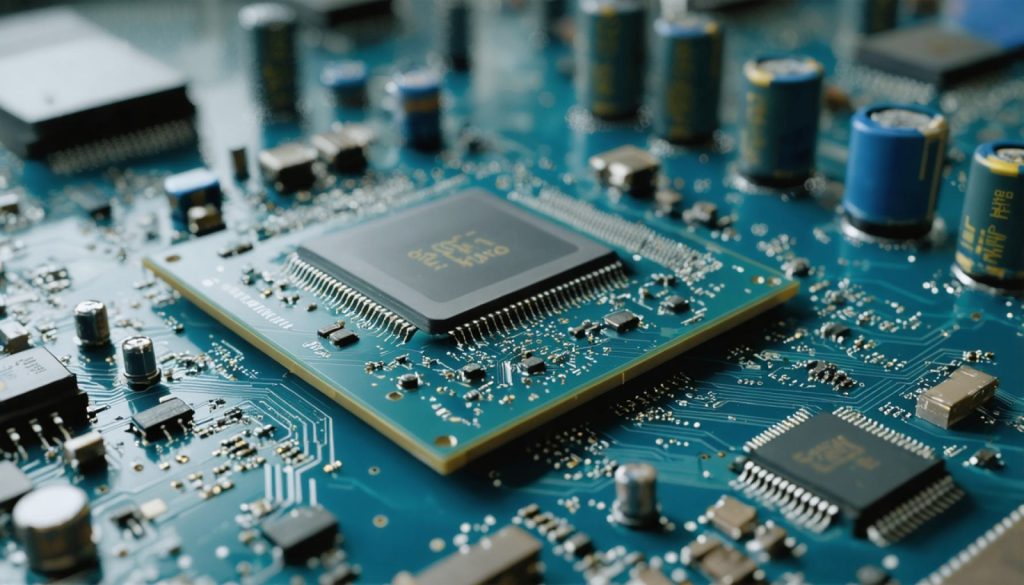
- The surge in global chip manufacturing is significantly increasing energy consumption and carbon emissions.
- Concentrated in East Asia, areas like Taiwan, South Korea, and Japan are central to this rise.
- The industry’s energy use in 2024 reached 984 gigawatt hours, a 350% increase from the previous year.
- Carbon emissions from chip manufacturing hit 453,600 metric tons, a fourfold increase.
- The demand for electricity in the tech sector could surpass Ireland’s entire consumption by 2030.
- Key players like Nvidia, Microsoft, Meta, and Google are urged to transition suppliers to renewable energy.
- While strides are being made, such as TSMC’s low-carbon initiatives, progress remains slow compared to energy demands.
- Balancing technological innovation with sustainability is essential for a greener future.
- The push for 100% renewable energy is not just a goal but an urgent necessity for both consumers and producers.
As the demand for cutting-edge technology skyrockets, a parallel story unfolds beneath the surface—a tale of rising energy consumption and its environmental aftermath. Largely concentrated in East Asia’s technological powerhouses—Taiwan, South Korea, and Japan—global chip manufacturing is inadvertently fueling a fossil fuel frenzy that can’t be ignored.
Each silicon chip powering our most advanced Artificial Intelligence systems comes with a hefty environmental price tag. In 2024, the industry’s energy usage reached an eye-popping 984 gigawatt hours, an astronomical 350% hike from the previous year. This surge led to carbon emissions soaring to 453,600 metric tons of carbon dioxide equivalent—a staggering fourfold increase in emissions threatening our planet.
It’s a conundrum wrapped in a circuit board: the race for innovation leading us down a path of resource depletion. While tech giants funnel billions into AI advancements, the transition to renewable energy across their supply chains remains surprisingly sluggish. But this isn’t just a distant problem; it’s a pressing issue with tangible impacts. By 2030, the sector’s electricity demands are set to eclipse Ireland’s entire current consumption.
This growing appetite for energy underscores a crucial need for change. Industry titans like Nvidia, Microsoft, Meta, and Google are urged to step up, guiding their suppliers toward renewable energy commitments. While some companies are taking strides, like TSMC’s endeavors in low-carbon manufacturing, the speed of this transition doesn’t match the accelerating demand. As environmental challenges loom large, the narrative calls for a conscious pivot to sustainable practices, not just innovation for innovation’s sake.
This tension between growth and sustainability is more than a business challenge—it’s an urgent call to action. For our digital futures to align with a healthy planet, it’s imperative that both consumers and producers activate change, making the dream of 100 percent renewable energy not just an ideal, but a reality.
How Silicon Chip Manufacturing is Impacting Our Planet and What We Can Do About It
Unveiling the Hidden Costs of Silicon Chip Manufacturing
The rapid advancement in technology has brought with it an often-overlooked consequence—rising energy consumption and its lasting effects on the environment. The global hub of chip manufacturing, mainly concentrated in Taiwan, South Korea, and Japan, is currently a significant driver of this trend. As demand for Artificial Intelligence (AI) systems and other technologies continues to skyrocket, so does the industry’s environmental footprint.
How-To Steps & Life Hacks: Reducing Your Tech Carbon Footprint
1. Choose Energy-Efficient Devices: Opt for electronics and appliances with the ENERGY STAR label or equivalent certifications in your region.
2. Support Sustainable Brands: Prioritize purchases from companies committed to reducing their carbon footprint by transitioning to renewable energy sources.
3. Extend Product Lifespan: Use your devices for longer by taking good care of them—avoid frequent upgrades unless necessary.
4. Offset Your Carbon Footprint: Consider donating to or investing in projects focused on renewable energy or reforestation.
Real-World Use Cases
– Corporate Sustainability Initiatives: Tech giants such as Adobe and Apple have made significant strides in powering their operations with renewable energy. Adobe, for example, is working towards powering its global operations and digital delivery of products entirely with renewable energy.
– Renewable Energy Shifts in Asia: Companies like TSMC and Samsung are increasingly investing in solar, wind, and other renewable energy initiatives to power their manufacturing processes.
Industry Trends & Insights
– Projected Energy Demands: By 2030, it’s predicted that the chip sector’s electricity consumption could surpass that of entire nations, such as Ireland. This emphasizes the necessity for a robust investment in sustainable energy solutions.
– Regulations and Policies: Governments in Asia are starting to enforce stricter regulations on energy consumption and emissions, encouraging companies to adopt cleaner energy sources.
Challenges and Limitations
– Infrastructure: Transitioning to renewable energy is hampered by infrastructure limitations, especially in regions heavily dependent on fossil fuels.
– Research and Development Costs: Investments in sustainable practices often require significant upfront costs, which can be a barrier for smaller companies.
Experts Weigh In
Dr. Laura Watts, an expert in sustainable technology, notes that “The transition to renewables is not just an environmental imperative but a strategic business move to ensure long-term viability and consumer trust.”
Recommendations for Immediate Action
– Educate and Engage: Companies should educate their supply chain partners about the benefits and techniques of renewable energy adoption.
– Collaborative Investments: Stakeholders should pool resources for shared sustainable infrastructure projects.
– Embrace Digital Twins: Use digital twin technology to simulate manufacturing processes and optimize energy use.
Related Resources
– Explore renewable energy initiatives and corporate sustainability commitments on the Nvidia and Microsoft websites.
The digital future is at our doorstep, but securing it demands conscientious action. By adopting sustainable practices, leveraging cutting-edge technology, and making informed consumer choices, we can pave the way for an innovation-driven yet environmentally responsible tomorrow.



